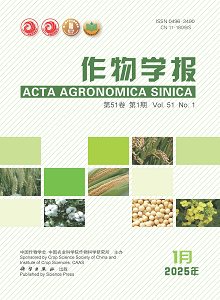Mechanism and technology of stand establishment improvements through regulating the apical hook formation and hypocotyl growth during seed germination and emergence in cotton
引用次数: 1
Abstract
: Realizing full and strong stand establishment of seedlings is the basis for achieving high yields and bump harvests in cotton. However, cotton is a dicotyledonous plant whose cotyledons are successfully all unearthed for standing. Seedling emergence is susceptible to environmental conditions and seeding techniques. Therefore, it is generally more difficult for cotton to get full and strong stand establishment than other major crops. The apical hook formation and the hypocotyl growth at seed germination and emergence stages play key roles in seedling emergence and stand establishment. Here we systemically reviewed the regulation mechanism of cotton seedling growth for the first time and put forward the key agronomic cultivation techniques to promote cotton seedling growth, focusing on the physiological and molecular mechanism of hook formation and hypocotyl growth and their influencing factors. Precision monoseeding can improve timely and moderate expression of the key genes HLS1 and COP1 related to hypocotyl elongation and hook formation, which assures better stand establishment by timely formation and expansion of the hooks and timely shedding of seed shells. The hypocotyl can grow steadily and form strong seedings by regulating the expression of key genes HY5 and ARF2 related to hypocotyl growth under precision monoseeding. In this paper, the key cultivation techniques of cotton precision monoseedling, combined with fine soil preparation, improving seed quality, plastic mulching, and drip irrigation under mulching were summarized and reviewed. This review provides important reference and guidance for the improvement and development of cotton sowing and cultivation technology in cotton.棉花种子萌发和出苗过程中顶钩形成和下胚轴生长调控改善林分建立的机理和技术
:实现整株结实是棉花实现高产高产的基础。然而,棉花是一种双子叶植物,其子叶都被成功地挖掘出来以供直立。幼苗的出苗易受环境条件和播种技术的影响。因此,棉花通常比其他主要作物更难获得完整和结实的林分。种子萌发和出苗阶段的顶端钩的形成和下胚轴的生长对幼苗的出苗和林分的建立起着关键作用。本文首次系统综述了棉花幼苗生长的调控机制,提出了促进棉花幼苗生长关键的农艺栽培技术,重点研究了钩形成和下胚轴生长的生理分子机制及其影响因素。精确单饲可以提高与下胚轴伸长和弯钩形成相关的关键基因HLS1和COP1的及时和适度表达,通过弯钩的及时形成和扩大以及种子外壳的及时脱落来确保更好的林分建立。下胚轴可以稳定生长,并通过调节与下胚轴生长相关的关键基因HY5和ARF2的表达形成结实的种子。本文对棉花精密单针、精细整地、提高种子质量、地膜覆盖和膜下滴灌等关键栽培技术进行了总结和评述。该综述为棉花播种栽培技术的改进和发展提供了重要的参考和指导。
本文章由计算机程序翻译,如有差异,请以英文原文为准。
求助全文
约1分钟内获得全文
求助全文
来源期刊

作物学报
Agricultural and Biological Sciences-Agronomy and Crop Science
CiteScore
1.70
自引率
0.00%
发文量
89
期刊介绍:
The major aims of AAS are to report the progresses in the disciplines of crop breeding, crop genetics, crop cultivation, crop physiology, ecology, biochemistry, germplasm resources, grain chemistry, grain storage and processing, bio-technology and biomathematics etc. mainly in China and abroad. AAS provides regular columns for Original papers, Reviews, and Research notes. The strict peer-review procedure guarantees the academic level and raises the reputation of the journal. The readership of AAS is for crop science researchers, students of agricultural colleges and universities, and persons with similar academic level.
 求助内容:
求助内容: 应助结果提醒方式:
应助结果提醒方式:


